Base camp to the sky..., 06.05.2004 - 18.05.2004.
|
The trouble with Everest is not that it is a very hard mountain.
It is just a little bit too high. Andre Roch, after the 1952 Swiss expedition had turned back at 8597m (28200ft). |
06.05.2004 Return to ABC, 5170m -> 6400m (17000ft -> 21000ft)
It is a long way to ABC. Unfortunately, when I came down from ABC, I had carelessly left some climbing gear in my pack, and with it, a sleeping bag, clothes, stove, two volumes of Proust,... my pack weighed about 30lbs. Left at 7:30 and arrived at ABC at 4:30 (8 hours walking).
I saw only a few climbers on the way including some Asian climbers going home, who cheerfully wished me “Good lucky” as we passed.
This was the first calm day since I had gone down to base camp. When I arrived back one of the Sherpas said (not quite accurately): "When you went to Camp 1 it was calm; when you went down to base camp it was calm; now when you come back to ABC it is calm; perhaps you will be lucky the whole way." Perhaps.
Kancha and Pemba have each made two carries to Camp 1 in the last two days.
07.05.2004, Rest.
Kanja and Pemba went to Camp 1 today. If, as planned, they can carry to Camps 2 and 3, then the camps will be ready for a summit attempt.

Kancha had a mini-puja before going up the mountain (he is a classy dresser).
Maite and Nuria went down to base camp.
Hugues and Maryse arrived back from base camp. According to the weather forecast they receive from Chamonix, tomorrow will be good, but then we'll have several days of bad weather. However May 16, 17, 18 may be possible summit days.
Based on the report, we plan to leave for the summit on May 15 (16 C2; 17 C3; 18 top).
08.05.2004, walk.
Hugues and Maryse leave after breakfast to spend 1-2 nights at the North Col --- they had so far spent only one night there.I walk up to the glacier at 6580m in 44 minutes, much faster than when I was here before. As I come down I pass a climber moving down very slowly and clumsily on the loose stones --- I can only hope he isn't planning to try to climb Chomolungma.
David comes down --- he has carried a tent and gear to camp 2.
09.05.2004, walk.
Usual walk. It is windy, but a few climbers seem to be going to Camp 2.Maryse and Hugues come down --- Maryse has been to about 7300m and Hugues made it to the top of the snow at 7500m.
Pemba and Kancha come down. Pemba is keen to reach the top. He has a friend on the south side who says that many people there are planning to attempt the summit on the 17th. Pemba suggested we go to Camp 1 on the 14th and attempt the top on the 17th .
10.05.2004 High winds.
Everyone is getting a bit irritable. Each year there has been a window when it has been possible to attempt the summit from the north, but what if this year is different?11.05.2004 High winds.
Sylvia comes up from base camp.12.05.2004 High winds.
Walk up to the glacier at 6580m in 39 minutes!Despite the wind, one of Brice's "trekking groups" goes up to the North Col. About 4pm I saw many people nearing the Col, and I saw two of the "trekkers" returning to ABC still wearing oxygen masks.
13.05.2004
It is still very windy in the morning, but the weather forecast is for the winds at 7000m to be14th (60kph); 15th (70kph); 16th (30kph); 17th (0kph); 18th (40kph). Then there will be bad weather until at least the 22nd.
A problem: there are no fixed ropes above Camp 3, and may not be any for many days since none of the guided groups are ready to attempt the summit. We discuss this, and decide that, if necessary, we'll climb without them. (Only Ang Babu bragged that this didn't bother him.)
I plan my attempt with Pemba and Kancha. I had been trying to decide whether to take one or two Sherpas on the summit day and, if one, which one. The problem was resolved when Kancha declared that he was sick. Sick or not, Pemba persuaded him to carry two bottles of oxygen to Camp 3.
Our plans: Pemba and I leave on the 14th and go to Camp 1; 15th Camp 2; 16th Camp 3; 17th summit. Kancha will go to Camp 2 on 15th and carry two bottles of oxygen to Camp 3 on 16th.
David, Hugues, and Maryse will also leave on the 14th and attempt the summit on the 17th.
14.05.2004. To Camp 1, 7080m/23230ft
My appetite at ABC has not been great, but at breakfast I felt almost as if I would vomit, and only managed to eat two bowls of cornflakes.Fortunately, once I started walking I felt much better, and reached the start of the fixed ropes in 2 hours. Towards the top I tired, and was passed by David and some of the Italians. Below the final slope, I had to wait while Brice's trekkers came down --- one managed to fall off and was left dangling on the rope until one of the guides rescued him. (There were two fixed ropes at this point, but it seemed prudent to stay well out of the way.) I reached Camp 1 in 5 hours, which was about an hour faster than my first time. Pemba came up later in 3 1/2 hours.
15.05.2004 To Camp 2, 7080m/23230ft -> 7650m/25100ft
Left at 9am, after the sun had warmed the tent.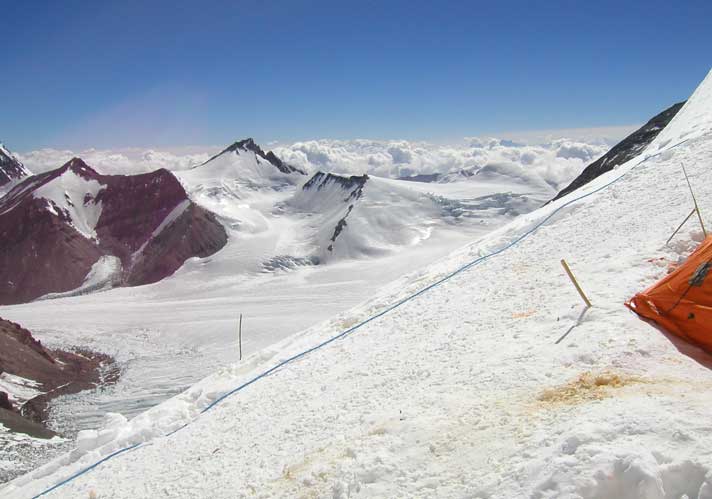
The view just before I set off.
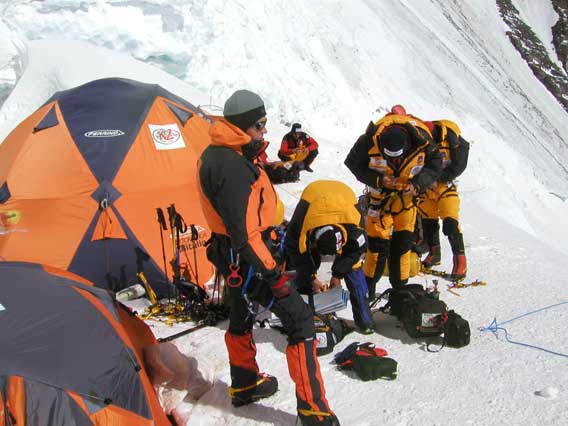
Sylvia (left) is ready to go for an acclimatization climb, while the Italians
(yellow suits) are preparing to go to Camp 2
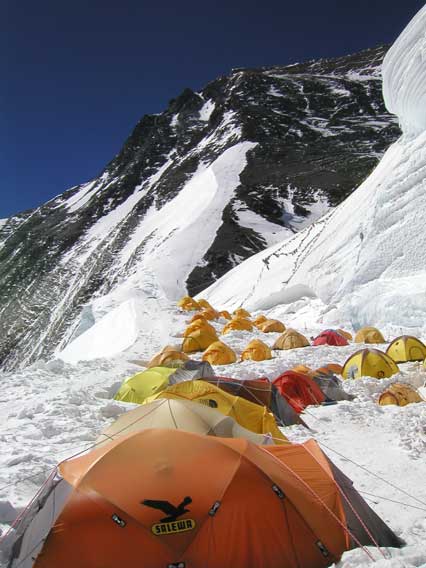
Some climbers can be seen already on the snow ridge.
I soon got into the wind, but in my down suit I was not cold. For a while I kept pace with the Italians who had passed me yesterday. I had planned to start using oxygen at the top of the snow (7500m/24600ft) in order to conserve energy for higher up, but when the "last" steep snow slope turned out to be the second last, the oxygen bottle in my pack began to weigh heavily and I started using it. At this altitude, the oxygen had only a small effect, but I managed to pass one of the Italians, who promptly quit his attempt, and returned down.
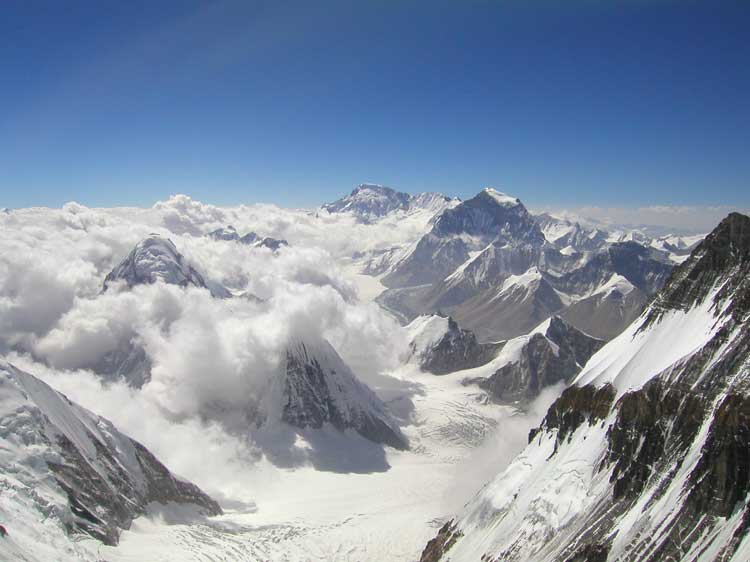
At the top of the snow, I stopped to admire the view (Cho Oyu in centre; Gyachung Kang to its right).
Reached our camp site at 4:30. Pemba had got there before me and put the tent up. It was very windy --- probably about 70kph.
Pemba had come up in 5 1/2 hours carrying 17kg/38lbs, and I and taken 7 1/2 hours carrying 12kg/27lbs.
16.05.2004 Camp 2
The wind dropped during the night to about 30kph, as predicted. I had slept for 9 hours using oxygen at 0.5 l/hr.Pemba said, that without Kancha, we would both have to carry heavy packs if we went to Camp 3 today. He suggested that I rest at Camp 2 today while he carries a load to Camp 3. Since the last two days had been hard, the next few looked harder, and Camp 2 was the last place where a rest might do good, I took no persuading.
Pemba left at 8am with a tent and three oxygen bottles. At 8:30am, Kancha arrived from Camp 1 with two oxygen bottles, and continued on to Camp 3.

A climber (right) on his way up while a camp-two resident watches

A climber stops to admire the view from a little below my tent; Camp 1 is visible.
A few days later, a climber fell from the rocks onto the snow and narrowly avoided tumbling
off to the left down to the Rongbuk glacier.
At 2pm, the Austrian group arrived outside my tent. They will try for the summit tomorrow from a camp at 7900m. (The tents of Camp 2 run from the top of the snow (7500m) to the point at which one leaves the north ridge (7900m)).
Proust being too heavy for 7650m/25100ft, I spent the day reading Three Men in a Boat and especially enjoyed the section on the stretchers fishermen tell --- mountain climbers are more reliable, mostly.
Kancha and Pemba arrive down at 3pm looking tired. Pemba says it will take me 8 hours tomorrow to reach Camp 3.
[The first climbers reached the summit from the south on the 15th, two days before anyone was able to attempt it from the north, and on the 16th ten parties reached the top from the south. The southern route is largely protected from the wind until Camp 3, whereas the northern route is exposed to it from Camp 1. Also, the route above Camp 3 on the south is fairly directly straight up and down whereas on the north there is a very long traverse on a ridge at over 8500m. For these reasons, the southern route is easier than the north, which explains its popularity despite the huge fees charged by the Nepalese.]
17.05.2004, To Camp 3, 7650m/25100ft -> 8300m/27230ft.
I set off for Camp 3 at 8am with a partly full oxygen bottle that will last me about 4 hours. Pemba would leave an hour later and catch me in time to give me a new bottle.It was a bit windy in the morning, but this was not really a problem. Climbed scree up the ridge to 7900m/25900ft.

(7900m/25900ft; 10:45am). View across the north face towards the summit. The
north ridge and face are not steep, but the strata slope down and the rock is
loose, and so it is a little like climbing a slate roof with loose slates. The
people in the yellow down suits are the Italians: at 6am the weather had
looked bad, and so they had turned back from their summit attempt; an hour later
it cleared, but by then it was too late.

(c8000m/26250m, 12:05pm). By midday my oxygen was running low, and so I found a
comfortable spot to stop. A few minutes later, Pemba arrived using oxygen (see photo), and
we had some hot drinks.
I continued following the traverse across, and soon saw the tents of Camp 3 looking quite close. I met a very happy Markus (of the Austrians). He said that they had reached the summit in 11 hours from their camp at 7900m. David had been very slow without oxygen, and had turned back at the northeast ridge. Maryse had turned back at about the same point with cold feet, but Hugues, despite a fall a little above Camp 3, had continued to the summit.
As Pemba had predicted, I arrived at Camp 3 at about 4pm. This is the highest commonly used camp in the world (c8300/27230ft). Resting I felt fine, and I was able to walk around the camp without oxygen. I think I could have descended from here without oxygen, but it was not something I wanted to risk.
[Altitudes above 8000m (the so-called "zone of death") are very dangerous - climbers trapped in their tents by prolonged storms can weaken and die in a matter of days. It was noticeable that the Sherpas avoided spending more than one night here.]
Pemba and I rested, drinking copious amounts of hot sweet drinks. We decided we would leave at 1 am tomorrow for the summit.
18.05.2004
We both had a good, if short, night --- we were both using oxygen to sleep. We woke at midnight as planned, but we didn’t manage to leave until 2am. Above the camp, the climbing was easy, but it became steeper as we neared the northeast ridge.There were fixed ropes from previous years, which were helpful for finding the route, but were not to be trusted --- the ultraviolet light at high altitudes weakens ropes, and a rope that looks strong may turn out higher up to be almost cut through by rubbing on a rock edge. I felt clumsy climbing in the dark in a down suit, double boots, and with an oxygen mask that made it difficult to see where I was putting my feet.
We arrived on the northeast ridge a little before 5am to spectacular views, and continued along the ridge a little way. According to my altimeter, we had climbed almost 300m above Camp 3 in three hours. At this point we were only about 350m below the summit, but over a kilometre away. We had reached the ridge quite quickly, and if we continued at the same pace, we could expect to reach the summit in about 5-6 hours.

The summit looked tantalizingly close
But as I looked up I could already see signs of winds higher up which we could expect to grow only worse. Together with the lack of any reliable protection, I decided that to push on to the summit would be too dangerous, and so, after taking some photos, we descended. (Pemba was willing to continue.) My best estimate is that we reached about 8500m/27900ft.

The view west towards Cho Oyu 8201m/26907ft (centre) with Gyachung Kang 79452m/26089 to its right.

Makalu 8475m/27806ft (the distant peak at left is Kangchenjunga 8586m/28169ft)
We could also see Lhotse 8501m/27920ft, but I neglected to take a photo of it.

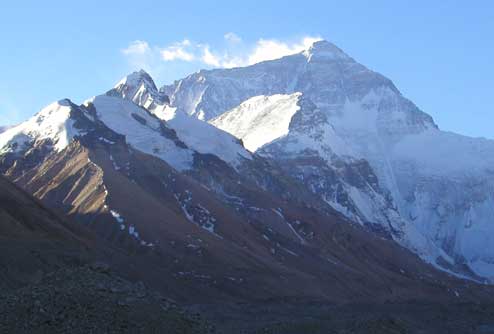
Pemba took this photo of me. At this point, when viewed from base camp, we
were on the skyline, close to where Mallory and Irvine had fallen to their deaths 80 years earlier.
In fact, as I feared, the winds did increase: by 10am, the summit had its familiar plume, and Pemba was blown over twice on the way down to Camp 2. That day two very experienced Korean climbers, who had both climbed K2, became trapped by high winds near the summit, and died there. [They may have continued in worsening winds in the hope of finding a team member who had gone missing the day before.] In the space of a few days, six climbers died on the northeast ridge (3 Koreans, 2 Bulgarians, and one Japanese).
One of those who died was attempting to be the first Bulgarian woman to reach the summit. As Ed. Hillary always says when asked about Mallory and Irvine, getting down is an important part of mountaineering.
By 7:30am, we were back at our tent, and I told Pemba that at 9:30 he could pack it up and head down. For 2 hours we rested and drank hot sweet drinks.
When 9:30 came, I found it very difficult to rouse myself from the comfort of my sleeping bag, but there was no choice. Besides, Pemba was starting to take the tent down.
In the tent, Pemba took a photo of me looking even more exhausted than I remember, and I managed to scramble out of the tent (without oxygen) and take a photo of it with the plumed summit of Chomolungma behind (Pemba can be seen inside packing up). Alas, my camera had slipped from MyMode to MovieMode (this happens also at sea level), and so we both took short movies. Following are a few frames (extracted by Pete Downie).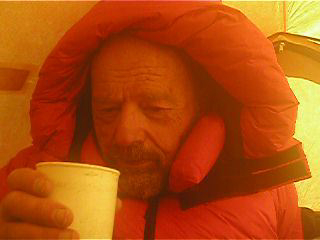
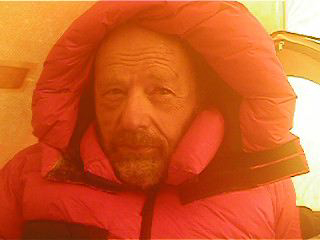
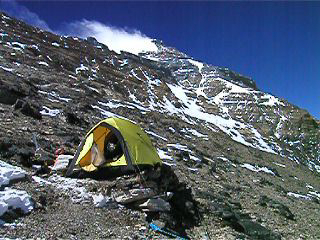
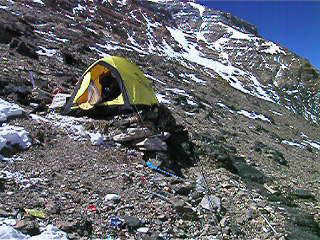
We both set off about 10am. About 8000m the tube from my oxygen bottle to the mask/regulator caught on a rock and popped off, and I lost some oxygen. A little later, my oxygen ran out, but I was so exhausted by then, that it didn't seem to matter. Descending the north ridge was very frustrating with the strong gusty wind and the loose stones. Not far above my tent I was passed by the remnants of the Korean expedition --- they seemed almost as tired as me.
Finally, I reached my tent. Pemba had continued down to Camp 1, but had kindly put a big ball of snow at the door of the tent. Thus, all I had to do was crawl inside and make myself hot drinks. The wind was very strong, and my tent was flapping quite a bit, but it didn’t seem to be in danger.